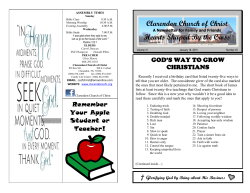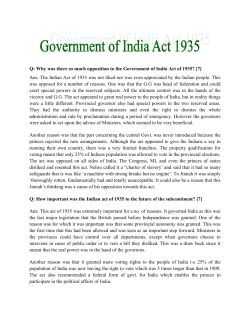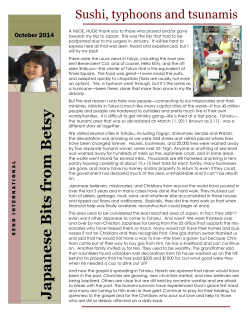
APUSH Summer Assignment
APUSH Summer Assignment Dear 2015-2016 APUSH student, I am so excited to get to know you and to study US history along side you starting in August! It is important that you understand that APUSH covers US history from 1492- the present, so we will move quickly, and a great deal of the work will be on your shoulders. I have designed a summer assignment for you to start getting used to learning history on your own so that when we start school we will all be prepared to offer up important information to the class. The summer assignment focuses on the first unit that we will cover together. It will be due the first week of school, so come prepared. I cannot wait for us to learn about the exciting history that our nation has together! Have a productive summer, Mrs. McNatt The summer assignment is in 3 parts: Part 1: The Columbian Exchange The Columbian exchange is the exchange of people, diseases, crops, animals, religions, etc. that occurred between the Old World (Europe) and the New World (the Americas) as the result of Columbus arriving in the New World in 1492. Chose 1 term from EACH of the following categories (A, B, and C) and write a 1-page essay for each. In the essay, describe where the food, animal, disease, etc. came from and where it ended up as the result of the Columbian Exchange. Then, explain the impact of the terms that you chose (How did they change the New or Old world?). Category A: Tobacco, Turkey, Cacao Bean, Potato, or Corn Category B: Coffee, Sugar cane, Wheat, Cattle, or Horse Category C: Smallpox, Influenza, or Measles Part 2: 10 Days that Unexpectedly Changed America: May 26, 1637, Massacre at Mystic Reading will be a key component to our class. Throughout the year, we will read the chapters from the 10 Days that Unexpectedly Changed America. For your summer assignment, I want you to read Chapter 1, which you can get from me before May 22 or in the main office of AHS over the summer. Answer the following questions as you read the chapter. 1. What does the massacre at Fort Mystic display about the beliefs the colonists had about Native Americans and themselves? 2. What expectations did the Puritans have for their life in the new world? 3. What caused the Pequot population to go from 13,000 to 3,000 by 1634? 4. What is wampum? How did the English ruin the Pequot’s economic power? 5. What portion of the future United States was gained by the Pequot as an economic obligation for murdering Englishmen. 6. What happened to cause the Puritans to wage war on the Pequot? 7. What was the lasting impact of the Pequot war? 8. Why was John Sassamon called the “Praying Indian”? 9. What happened between the colonists and the Narragansett in December of 1675? 10. Define Manifest Destiny from another source. What does this chapter say that a main ingredient of Manifest Destiny would be? 11. What action did President Jackson take against the Native Americans in 1830? 12. Create a timeline of the destruction and rebuilding of the Pequot people. Use events from the following years: 1637, 1638, 1666, 1921, 1973, 1983, 1986, 1992, 2000 Part 3: Analyzing primary sources For this class, we will use an activity called SOAPSTone to analyze primary sources. S- speaker (who wrote it) O- occasion (when in it happening,/at what event) A- audience (who is the speaker talking to) P- purpose (why was it written) S- subject (what is it about) Tone (how does the speaker feel when writing this; angry, hopeful, excited, concerned, etc.) For the following 4 documents, I want you to identify the SOAPSTone. Document 1 “In obedience to your Highnesses' commands, and with submission to superior judgment, I will say whatever occurs to me in reference to the colonization and commerce of the Island of Espanola, and of the other islands, both those already discovered and those that may be discovered hereafter. . . As regards the division of the gold, and the share that ought to be reserved for your Highnesses, this, in my opinion, must be left to the aforesaid governor and treasurer, because it will have to be greater or less according to the quantity of gold that may be found. Or, should it seem preferable, your Highnesses might, for the space of one year, take one half, and the collector the other, and a better arrangement for the division be made afterward.” Christopher Columbus, 1492 Document 2 “Concerning the treatment of Native American workers: When they were allowed to go home, they often found it deserted and had no other recourse than to go out into the woods to find food and to die. When they fell ill, which was very frequently because they are delicate people unaccustomed to such work, the Spaniards did not believe them and pitilessly called them lazy dogs, and kicked and beat them; and when illness was apparent they sent them home useless, giving them some cassava for the twenty- to eighty league journey. They would go then, falling into the first stream and dying there in desperation; others would hold on longer, but very few ever made it home. I sometimes came upon dead bodies on my way, and upon others who were gasping and moaning in their death agony, repeating “Hungry, hungry.” Bartolome de Las Casas, priest and social reformer Document 3 De Soto's Discovery of the Mississippi, 1541. Document 4 “Our desire is that the Christians not lack people to work their holdings and to take out what gold there is. It also is our desire that the Indians live in community with the Christians, because they then will help each other cultivate and settle the island, take out the gold, and bring profit to Spain. Therefore, we command you, our governor, to compel the Indians to associate with the Christians. The Indians should work on the Christians’ building, mind the gold, till the fields, and produce food for the Christians. This the Indians shall perform as free people, which they are, and not as slaves. Also, see to it that the Indians are well treated, with those who become Christians better treated than the others. Do not consent or allow any person to do them any harm or oppress them.” letter from King Ferdinand and Queen Isabella to the governor of Hispaniola in 1503
© Copyright 2025












